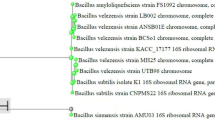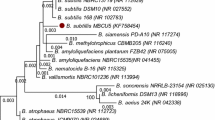Abstract
Plant pathogens caused severe economic losses to the agricultural farming. Members of the genus Bacillus are considered to be a natural laboratory for the production of biologically active molecules that are strong inhibitors for the growth of phytopathogens. GJ-01 bacterial strain was isolated from crude oil-contaminated soil and later identify as Bacillus siamensis AMU03 through morphological, biochemical tests and molecular sequencing method. Culture conditions provided for the biosurfactant activity was highest with surface activity had a pH of 7 at 37 °C during the 7-day incubation period. A significant level of > 50% pathogen growth was inhibited under dual culture and at 3% culture filtrate in food poisoning method. The chemical composition of the biosurfactant was elucidated by the use of Thin layer chromatography and Fourier transform–infrared spectroscopy, and it was adjudged that the extract belongs to lipopeptides-surfactin class. This may help in future research studies in the area of diseases management strategies.






Similar content being viewed by others
References
Anandaraj B, Thivakaran P (2010) Isolation and production of biosurfactant producing organism from oil spilled soil. J Biosci Technol 1(3):120 126
Anis M, Abbasi MW, Zaki MJ (2010) Bioefficacy of microbial antagonists against Macrophomina phaseolina on a sunflower. Pak J Bot 42:2935–2940
Asaka O, Shoda M (1996) Biocontrol of Rhizoctonia solani damping off of tomato with Bacillus subtilis RB14. Appl Environ Microbiol 62:4081–4085
Banat IM, Franzetti A, Gandolfi I, Bestetti G, Martinotti MG, Fracchia L, Smith TJ, Marchant R (2010) Microbial biosurfactants production, applications and future potential. Appl Microbiol Biotechnol 87:427–444
Bayoumi RA, Haroun BM, Ghazal EA, Mahe YA (2010) Structural analysis and characterization of biosurfactants produced by some crude oil utilizing bacterial strains. Aust J Basic Appl Sci 4:3484–3498
Bezza FA, Chirwa EMN (2015) Production and applications of lipopeptide biosurfactant for bioremediation and oil recovery by Bacillus subtilis CN2. Biochem Eng J 101:168–78
Hussain T, Khan AA (2018a) Bacillus firmus HussainT: Lab. 66: A new Biosurfactant producing bacteria for the biocontrol of late blight of potato caused by Phytophthora infestans (Mont.) de Bary. In: National Seminar on new paradigms of plant health management: sustainable food security under climatic scenario from 17th Nov to 19th Nov 2018 at Bihar Agricultural University, Sabour (Bhagalpur), Bihar, India under Indian Phytopathological Society, Eastern Zone region Annual meeting. OP, p 60
Bodour AA, Maier RM (1998) Application of a modified dropcollapse technique for surfactant quantification and screening of biosurfactant- producing microorganisms. J Microbiol Methods 32:273–280
Chandankere R, Yao J, Cai M, Masakorala K, Jain AK, Choi MMF (2014) Properties and characterization of biosurfactant in crude oil biodegradation by bacterium Bacillus methylotrophicus UST. Fuel 122:140–148
Ferradji FZ, Mnif S, Badis A, Rebbani S, Fodil D, Eddouaouda K (2014) Naphthalene and crude oil degradation by biosurfactant producing Streptomyces spp. isolated from Mitidja plain soil (North of Algeria). Int Biodeterior Biodegrad 86:300–308
Ghojavand H, Vahabzadeh F, Mehranian M, Radmehr M, Shahraki KA, Zolfagharian F, Emadi MA, Roayaei E (2008) Isolation of thermotolerant, halotolerant, facultative biosurfactant-producing bacteria. Appl Microbiol Biotechnol 80:1073–1085
Gravel V, Martinez C, Antoun H, Tweddel RJ (2005) Antagonistic microorganisms with the ability to control Pythium damping-off of tomato seeds in rockwool. Biocontrol 50:771–786
Grover RK, Moore JD (1962) Toximetric studies of fungicides of brown rot organism Sclerotinia fruticola and S. laxa. Phytopathology 52:876–880
Heimpel GE, Mills N (2017) Biological control-ecology and applications. Cambridge University Press, Cambridge
Hultberg M, Bengtsson T, Liljeroth E (2010) Late blight on potato is suppressed by the biosurfactant-producing strain Pseudomonas koreensis 2.74 and its biosurfactant. BioControl 55:543–550
Hussain T, Khan AA (2018b) A combination of rapid and easy assays of biosurfactant producing bacteria strain isolated from automobiles repairing workshop in Aligarh. Proc Voronezh State Univ Eng Technol 80(3):153–163
Hussain T, Khan AA (2020) Bacillus subtilis HussainT-AMU and its antifungal activity against Potato black scurf caused by Rhizoctonia solani. Biocatal Agric Biotechnol 23:101433
Ibrahim ML, Ijah UJJ, Manga SB, Bilbis LS, Umar S (2013) Production and partial characterization of biosurfactant produced by crude oil degrading bacteria. Int Biodeterior Biodegrad 81:28–34
Jana TK, Sharma TR, Singh NK (2005) SSR-based detection of genetic variability in the charcoal kinase of Trichoderma virens, is involved in biocontrol properties and repression of conidiation, pathogenicity, pycnidium production and chlorate utilization for root rot pathogen Macrophomina phaseolina. Can J Bot 73:1596–1603
Jharia HK, Duhoon SS (2000) Interactions between antagonists and Macrophomina phaseolina causing stem and root rot in sesame. In: Paper presented in National Seminar on oilseeds and oils research and development need in the Millennium Held at DOR, Hydrabad: 218(Ab)
Jones TS (1949) Chemical evidence for the multiplicity of the antibiotics produced by Bacillus polymyxa. Ann N Y Acad Sci 51:909–916
Juwarkar AA, KV Dubey A, Nair, Singh SK (2008) Bioremediation of multi-metal contaminated soil using biosurfactant—a novel approach. Ind J Microbiol 48:142–146
Kaisar SAKM, Das SN (1988) Physical factors that influence the growth and spread of charcoal rot pathogen (Macrophomina phaseolina) infecting maize. J Phytopathol 123:47–51
Khan SN (2007) Macrophomina phaseolina as causal agent for charcoal rot of sunflower. Mycopath 5(2):111–118
Khirood D, Paramjit KJ (2012) In vitro efficacy of Trichoderma viride against Sclerotium rolfsii and Macrophomina phaseolina. Sci Biol 4(4):39–44
Krishnayya PV, Grewal PS (2002) Effect of neem and selected fungicides on viability and virulence of the entomopathogenic nematode steinernema feltiae. Biocontrol Sci Technol 12:259–266
Yoon et al (2017) Introducing EzBioCloud: a taxonomically united database of 16S rRNA and whole genome assemblies. Int J Syst Evol Microbiol 67:1613–1617
Lee D, Kim IY, Saha S, Choi KS (2016) Paraptosis in the anti-cancer arsenal of natural products. Pharmacol Ther 162:120–133
Lokesha NM, Benagi VI (2007) Biological management of pigeonpea dry root rot caused by Macrophomina phaseolina. Karnataka J Agric Sci 20:54–56
Morikawa M, Hirata Y, Imanaka T (2000) A study on the structure function relationship of lipopeptide biosurfactants. Biochim Biophys Acta 1488:211–218
Nakhate PH, Yadav VK, Pathak AN (2013) A review on daptomycin: the first US-FDA approved lipopeptide anti-biotics. J Sci Innov Res 2:970–980
Padmapriya B, Rajeswari T, Suganthi S, Rajeswari T, Jayalakshmi S (2011) Biosurfactant production and plasmid isolation from newly isolated hydrocarbonoclastic bacteria Proteus inconstans. Int J Pharm Biol Arch 2:784–790
Pal KK, Tilak KVBR, Saxena AK, Dey R, Singh CS (2001) Suppression of maize root diseases caused by M. phaseolina, Fusarium moniliforme and Fusarium graminearum by plant growth promoting rhizo bacteria. Microbiol Res 156:209223
Raaijmakers JM, Mazzola M (2012) Diversity and natural functions of antibiotics produced by beneficial and plant pathogenic bacteria. Annu Rev Phytopathol 50:403–424
Rabindran R, Vidhyasekaran P (1996) Development of a formulation of Pseudomonas fluorescens PfALR2 for management of rice sheath blight. Crop Protect 15:715–721
Satpute SK, Bhawsar BD, Dhakephalkar PK, Chopade BA (2008) Assessment of different screening methods for selecting biosurfactant producing marine bacteria. Indian J Mar Sci 37:243–250
Silva CL. Ciampi yL, Burzio (1997) Caracterización preliminar de un metabolito de Bacillus sp. con actividad antibiótica. In VI Congreso Nacional de Fitopatología. Talca Resúmenes Simiente 67:68–95
Singh G, Verma RK (2015) Compatibility of bioagents and neem products against root rot of soybean. J Mycopathol Res 43(2):211–214
Singh N, Pandey P, Dubey RC, Maheshwari DK (2008) Biological control of root rot fungus Macrophomina phaseolina and growth enhancement of Pinus roxburghii (Sarg.) by rhizosphere competent Bacillus subtilis BN1. World J Microbiol Biotechnol 24(9):1669–1679
Snook ME, Mitchell T, Hinton DM, CW, Bacon (2009) Isolation and characterization of Leu7-surfactin from the endophytic bacterium Bacillus mojavensis RRC 101, a biocontrol agent for Fusarium verticillioides. J Agric Food Chem 57:4287–4292
Sriram MI, Kalishwaralal K, Deepak V, Gracerosepat R, Srisakthi K, Gurunathan S (2011) Biofilm inhibition and antimicrobial action of lipopeptide biosurfactant produced by heavy metal tolerant strain Bacillus cereus NK1. Colloid Surf B Interfaces 85:174–181
Srivastava AK, Singh T, Jana TK, Arora DK (2001) Induced resistance and control of charcoal rot in chickpea. Plant Dis 84:377–393
Sundravadana S (2002) Management of blackgram (Vigna mungo (L). Hepper) root rot (Macrophomina phaseolina (Tassi.) Goid with bioagents and nutrients. M.Sc. Thesis. Department of Plant Pathology, Tamil Nadu Agricultural University, Tamil Nadu
Szczech M, Shoda M (2006) The effect of mode of application of Bacillus subtilis RB14-C on its efficacy as a biocontrol agent against Rhizoctonia solani. J Phytopathol 154:370–377
Vidyasekaran P, Muthamilan M (1995) Development of formulations of Pseudomonas fluorescens for control of chickpea wilt. Plant Dis 79:782–786
Vincent JM (1947) Distortion of fungal hyphae in the presence of certain inhibitors. Nature 159:850
Vyas SC, Patel MC (2015) Integrated biological and chemical control of dry root rot of chickpea. Indian J Mycol Plant Pathol 24(2):132–134
Youssef NH, Duncan KE, Nagle DP, Savage KN, Knapp RM, McInerney MJJ (2004) Comparison of methods to detect biosurfactant production by diverse microorganisms. Microbiol Methods 56(3):339–347
Zape AS, Gade RM, Singh R, Deshmukh VA (2014) Efficacy of different antagonist against the Sclerotium rolfsii. Rhizoctonia solani and Fusarium solani. Bioscan 9(4):1431–1434
Zhang J, Xue Q, Gao H, Lia H, Wang P (2016) Production of lipopeptide biosurfactants by Bacillus atrophaeus 5-2a and their potential use in microbial enhanced oil recovery. Microb Cell Fact 15:168
Zhao HB, Shao DY, Jiang CM, Shi JL, Li Q, Huang QS, Rajoka MSR, Yang H, Jin ML (2017) Biological activity of lipopeptides from Bacillus. Appl Microbiol Biotechnol 101(15):5951–5960
Acknowledgements
The first author is very thankful to Startup Grant, by Dept. of Science and Technology, Indian Government, New Delhi for providing the financial grants received under File No. DST-SERB-NPDF/2016/001409 and Dept. of Botany, Aligarh Muslim University, Aligarh, U.P for proving all the support, infrastructure, Dept. of Chemistry, AMU, Aligarh for FT-IR facility.
Author information
Authors and Affiliations
Corresponding author
Ethics declarations
Conflict of interest
The authors declare that they do not have any conflict of interest.
Additional information
Publisher's Note
Springer Nature remains neutral with regard to jurisdictional claims in published maps and institutional affiliations.
Rights and permissions
About this article
Cite this article
Hussain, T., Khan, A.A. Determining the antifungal activity and characterization of Bacillus siamensis AMU03 against Macrophomina phaseolina (Tassi) Goid. Indian Phytopathology 73, 507–516 (2020). https://doi.org/10.1007/s42360-020-00239-6
Received:
Revised:
Accepted:
Published:
Issue Date:
DOI: https://doi.org/10.1007/s42360-020-00239-6




